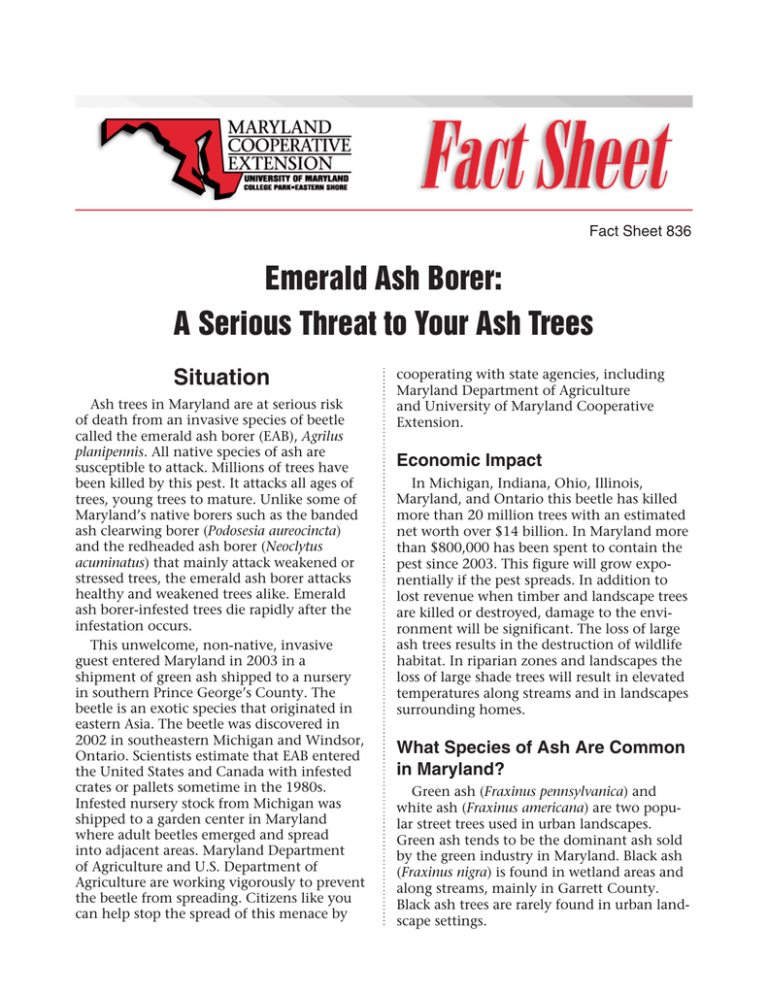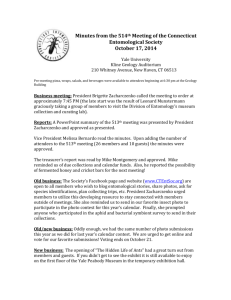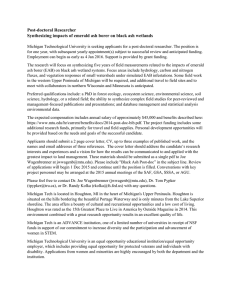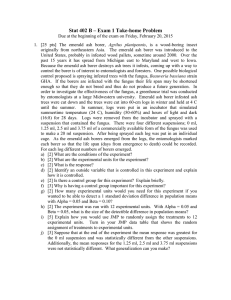Emerald Ash Borer: A Serious Threat to Your Ash Trees Situation
advertisement

Fact Sheet 836 Emerald Ash Borer: A Serious Threat to Your Ash Trees Situation Ash trees in Maryland are at serious risk of death from an invasive species of beetle called the emerald ash borer (EAB), Agrilus planipennis. All native species of ash are susceptible to attack. Millions of trees have been killed by this pest. It attacks all ages of trees, young trees to mature. Unlike some of Maryland’s native borers such as the banded ash clearwing borer (Podosesia aureocincta) and the redheaded ash borer (Neoclytus acuminatus) that mainly attack weakened or stressed trees, the emerald ash borer attacks healthy and weakened trees alike. Emerald ash borer-infested trees die rapidly after the infestation occurs. This unwelcome, non-native, invasive guest entered Maryland in 2003 in a shipment of green ash shipped to a nursery in southern Prince George’s County. The beetle is an exotic species that originated in eastern Asia. The beetle was discovered in 2002 in southeastern Michigan and Windsor, Ontario. Scientists estimate that EAB entered the United States and Canada with infested crates or pallets sometime in the 1980s. Infested nursery stock from Michigan was shipped to a garden center in Maryland where adult beetles emerged and spread into adjacent areas. Maryland Department of Agriculture and U.S. Department of Agriculture are working vigorously to prevent the beetle from spreading. Citizens like you can help stop the spread of this menace by cooperating with state agencies, including Maryland Department of Agriculture and University of Maryland Cooperative Extension. Economic Impact In Michigan, Indiana, Ohio, Illinois, Maryland, and Ontario this beetle has killed more than 20 million trees with an estimated net worth over $14 billion. In Maryland more than $800,000 has been spent to contain the pest since 2003. This figure will grow exponentially if the pest spreads. In addition to lost revenue when timber and landscape trees are killed or destroyed, damage to the environment will be significant. The loss of large ash trees results in the destruction of wildlife habitat. In riparian zones and landscapes the loss of large shade trees will result in elevated temperatures along streams and in landscapes surrounding homes. What Species of Ash Are Common in Maryland? Green ash (Fraxinus pennsylvanica) and white ash (Fraxinus americana) are two popular street trees used in urban landscapes. Green ash tends to be the dominant ash sold by the green industry in Maryland. Black ash (Fraxinus nigra) is found in wetland areas and along streams, mainly in Garrett County. Black ash trees are rarely found in urban landscape settings. When grown under proper conditions ash trees are valuable landscape plants with many desirable traits including rapid growth rate, adaptability to different soil types, and pleasing growth habits. These good characteristics have contributed to the extensive use of ash species in street tree plantings, lawns, parks, and commercial office building landscapes. Unfortunately, many landscape sites in urban and suburban locations lack the proper growing conditions needed for ash trees to be at their best. Ash trees planted in parking lots or hot drought-prone areas appear to have major problems with the native insect pests including other borers, such as banded ash clearwing borer and redheaded ash borer. These borers cause canopy thinning, branch dieback, and, in some cases, eventual death of the tree. However, they are far less aggressive than the EAB. Even healthy green and white ash can fall victim to this lethal pest. White ash growing in forested areas of Maryland contribute to the diversity of veg- etation, but they are not a dominant species in most woodlands where oak, maple, and tulip poplar tend to rule by sheer numbers. Nonetheless, white ash is an important forest tree species. Ash continues to be planted in mitigation and restoration projects throughout Maryland. How to Recognize the Invasive Species of Emerald Ash Borer First, to determine whether the trees being examined are ash trees, go to the website http://www.hgic.umd.edu/content/emeraldAshBorer.cfm and look at the “How to Identify Ash” section. Next, examine the tree and determine if it is experiencing severe dieback. Often trees infested with EAB have vigorous shoots emanating from the trunk (called epicormic growth). See photos of epicormic growth at http://www.michigan.gov/dnr/0,1607,7-153-30301_ 30505_40936-140069--,00.html. Emerald ash borer exit holes. Emerald ash borer damage under tree bark. _”¼ Examining tree trunks and branches University of Maryland Cooperative Extension websites: Look for exit holes from which adults have emerged. The EAB makes a small Dshaped hole (1⁄8–¼”) in the bark as adults emerge. Because the bark of ash is rough, you may need to remove some bark to see this D-shaped exit hole. In urban settings the banded ash clearwing borer often infests ash. Their emergence hole is larger, usually ¼–³⁄8” and rounded. Weakened ash trees can also be attacked by the redheaded ash borer, which makes a more oval-shaped hole of ¼–³⁄8”. www.agnr.umd.edu/IPMNET http://www.hgic.umd.edu/content/ EmeraldAshBorer.cfm http://www.raupplab.umd.edu/bugweek/ archive/BugOfWeek_38A.html Maryland Department of Agriculture websites: www.mda.state.md.us www.mdinvasivesp.org/species/insects/ Emerald_Ash_Borer.html Conclusion Maryland Department of Natural Resources website: The introduction of the emerald ash borer can have a devastating environmental impact on our forested, urban, and suburban ecosystems. We need the public to work closely with state and county agencies to keep the emerald ash borer contained. If you suspect that you have found an infestation of EAB, please report it using the form contained at the following website: http://www.hgic.umd. edu/content/emeraldAshBorer.cfm. For more information on EAB, visit the following websites: http://www.dnr.state.md.us/forests/forester/eab.asp USDA websites: www.aphis.usda.gov/ppq/ep/eab http://na.fs.fed.us/fhp/eab/ Emerald ash borer larva. Emerald ash borer adult. Emerald Ash Borer: A Serious Threat to Your Ash Trees by Stanton Gill, Regional Specialist in Nursery, Greenhouse and Landscape IPM, Central Maryland Research and Education Center, University of Maryland Cooperative Extension sgill@umd.edu, www.agnr.umd.edu/IPMNET Michael Raupp, Ph.D., Extension Specialist and Acting Associate Dean and Director of University of Maryland Cooperative Extension, University of Maryland mraupp@umd.edu Suzanne Klick Technician Central Maryland Research and Education Center University of Maryland Cooperative Extension Shannon Wadkins Technician Central Maryland Research and Education Center University of Maryland Cooperative Extension Issued in furtherance of Cooperative Extension work, acts of May 8 and June 30, 1914, in cooperation with the U.S. Department of Agriculture, University of Maryland, College Park, and local governments. Cheng-i Wei, Director of Maryland Cooperative Extension, University of Maryland. The University of Maryland is equal opportunity. The University’s policies, programs, and activities are in conformance with pertinent Federal and State laws and regulations on nondiscrimination regarding race, color, religion, age, national origin, gender, sexual orientation, marital or parental status, or disability. Inquiries regarding compliance with Title VI of the Civil Rights Act of 1964, as amended; Title IX of the Educational Amendments; Section 504 of the Rehabilitation Act of 1973; and the Americans With Disabilities Act of 1990; or related legal requirements should be directed to the Director of Human Resources Management, Office of the Dean, College of Agriculture and Natural Resources, Symons Hall, College Park, MD 20742.






